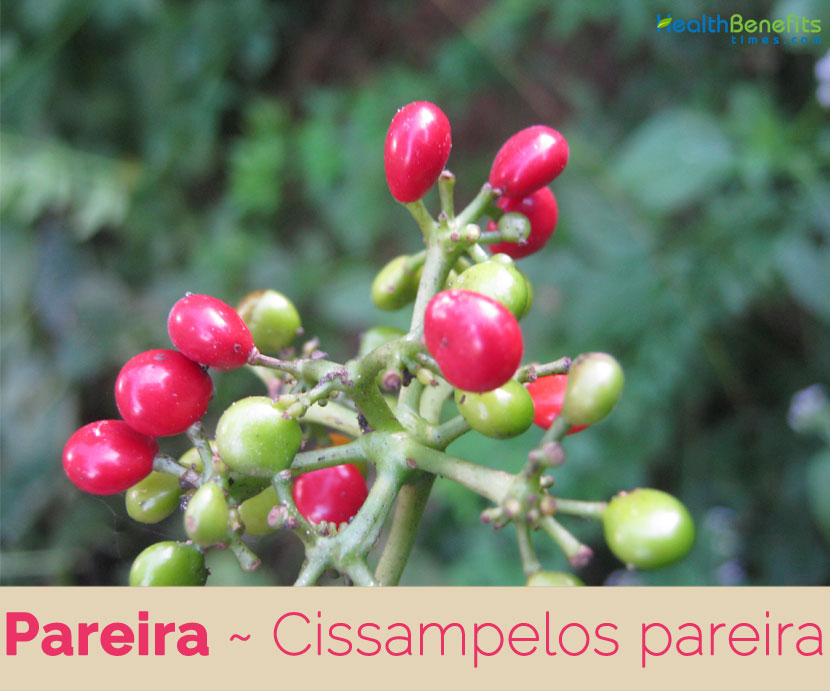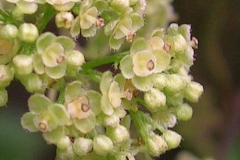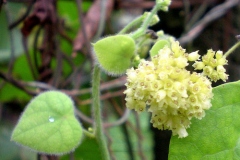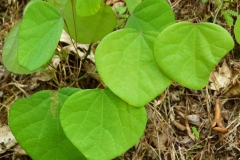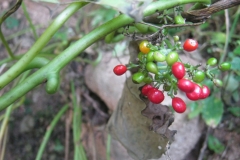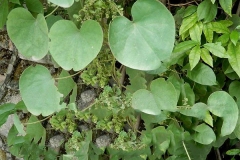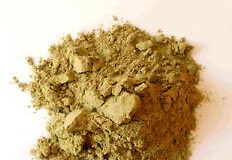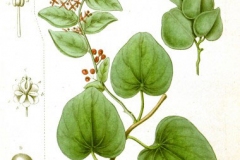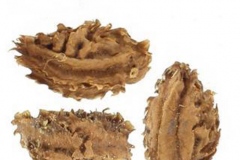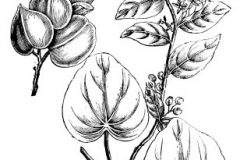| Pareira Quick Facts | ||
|---|---|---|
| Name: | Pareira | |
| Scientific Name: | Cissampelos pareira | |
| Origin | Florida, although rare or possibly locally extinct | |
| Colors | Green when young turning to red or red-orange | |
| Shapes | Juicy, globose or slightly laterally compressed hairy drupes 4 to 5 mm in diameter. | |
| Taste | Bitter, astringent | |
| Health benefits | Beneficial for Bruises, fever, Diarrhea, Dysentery, Malaria, Constipation, Rashes, Swellings, Scorches, Ulcers, Oral ailments, Asthma, Wheezing, Bronchitis, Kidney infections, Hypertension | |
| Plant Part | Documented Ethnic Use | Route of Administration |
| Entire Plant | It is used for snakebite, where the plant is made into a fine paste and applied to the bite. Also, the juice is poured into the ears, nostrils, and naval cavity. | External use |
| Aerial parts(part of plant exposed to air) | The aerial parts of Pareira are used for temporary control of conception | Oral |
| Plant Juice | Plant juice of Pareira is used for minor injuries and snakebite. The juice is mixed with egg and jaggery. | Oral for minor injuries and external application for snakebite. |
|
Leaf
|
Used for pimples, boils, cuts, wounds, and burns. | External use |
| Leaves are ground and applied on the forehead for fever and common cold. | External use | |
| Also used for coughs, cold, and as a contraceptive medicine. | Oral | |
| Leaf Juice | The leaves juice of Pareira plant is used to treat sores, abdominal pain, and eye ailments. | External use |
| Leaf+ Root | The paste, made out of leaves + root of Pareira, is used to treat toothache. | Oral |
| Root | The root paste of Pareira is used to treat fever, sprains, and cure wounds. | External use |
| The roots of Pareira plant are used as an anti-fertility agent, emmenogogue (a substance that stimulates blood flow in the pelvic area), and as a diuretic. Also, they are used to treat heart troubles, dysentery, asthma, and remove intestinal worms. | Hot water extract oral | |
| Pareira roots can be used to treat malarial fever, and colic. | Oral | |
| The decoction of Pareira roots is used to treat typhoid fever. | Oral (Decoction) |
Worldwide Ethno-medical Uses
| Country | Disease |
| Amazonia | For childbirth, colic, fever, muscle spasms and pain, nervous children, pinta, snakebite |
| Argentina | For diarrhea, menstrual disorders, respiratory tract infections, urinary tract infections |
| Brazil | For abortions, anemia, asthma, bladder problems, colic, congestion, constipation, contusions, cramps, cystitis, digestive problems, detoxification (by inducing sweating), dysentery, dyspepsia, drowsiness, edema, excessive phlegm and mucous, fever, gallbladder problems (to stimulate bile), hepatitis, inflammation, kidney stones, menstrual disorders, muscle aches, pains and spasms, testicular inflammation, threatened miscarriage, pre-and postnatal pain, rheumatism, snakebite, stomach problems, urinary tract disorders, uterine hemorrhages, water retention |
| Guatemala | For cramps, erysipelas, fever, menstrual disorders, rheumatism, snakebite, water retention, and to increase perspiration |
| Mexico | For bladder problems, dermatitis, diarrhea, dysentery, edema, excessive phlegm and mucous, fever, insect bites, jaundice, menstrual disorders, muscle inflammation, nephritis, pain, pimples, rheumatism, snakebite, urogenital problems, vaginal discharge, water retention, and as a female balancing aid |
| Nicaragua | For bites, fever, skin rash, sores, stings, venereal disease |
| U.S | For hemorrhages and excessive bleeding, constipation, kidney stones, menstrual disorders, muscle spasms, premenstrual syndrome (PMS), testicular inflammation, urinary tract irritation, water retention |
| Venezuela | For bladder problems, kidney stones, snakebite; also used as a diuretic |
| Elsewhere | For abortions, anemia, arrow poisoning, asthma, boil, childbirth, constipation, cough, cystitis, diabetes, diarrhea, dyspepsia, excessive phlegm and mucous, edema, eye problems, fetal growth problems, fever, hemorrhages, hypertension, indigestion, itch, kidney stones, malaria, menstrual disorders, pain, post-menstrual hemorrhages, rheumatism, snakebite, sores, sterility, threatened miscarriage, urogenital inflammation, uterine hemorrhage, venereal disease, water retention, wounds and as a female balancing aid. |
Traditional uses and benefits of Pareira Plant
- Paste is made from whole plant and applied locally to treat inflammatory conditions of the eye.
- Decoction of the roots is used for colic and blennorrhea in Indo-China.
- Leaves are anti-scabious, also applied to snakebites in Philippines.
- Decoction of the roots is diuretic, lithontriptic, pectoral, febrifuge, diaphoretic, emmenogogue, tonic, and sedative.
- It is useful in curbing skin ailments like, Acne.
- It also helps in curing bruises, rashes, swellings, scorches, ulcers, stings and bites.
- It is beneficial in treating toothaches and other oral ailments like mouth ulcers.
- It is helpful in treating respiratory ailments like Asthma, Wheezing, Bronchitis and Cold.
- It is a good herbal remedy for treating kidney ailments like kidney infections and kidney stone.
- It takes care of the Liver and helps in keeping the Liver healthy.
- It is also effective is curing ailments like high fever, diarrhea, dysentery, malaria and constipation.
- It is a good herbal remedy especially for women.
- It is beneficial during Menopause.
- It relieves unbearable pain, bleeding and contraction of muscles.
- It is also beneficial in curing the trouble of fibroids during menopause.
- It is helpful in avoiding miscarriage, stillbirth and bleeding from the Uterus post-delivery.
- It is also effective in curing ailments relating to the reproductive organs.
- It also protects against urine and urinary tract infections.
- It helps in maintaining the level of hormones therefore enabling proper functioning of the body.
- It is also beneficial in treating joint inflammation ailment like, arthritis.
- Infusion of the bitter rhizome, leaves and stems, are used to cure gastro-intestinal complaints such as diarrhea, dysentery, ulcers, colic, intestinal worms and digestive complaints, and also urogenital problems such as menstrual problems, venereal diseases, infertility, uterine bleeding and threatening miscarriage.
- Rhizome decoction or pounded leaves are also widely taken or externally applied as a febrifuge and stomachic, and against cough, heart trouble, rheumatism, jaundice, snake bites and skin infections such as sores, boils, scabies and childhood eczema.
- Rhizome is used as a diuretic and against acute and chronic bladder inflammation, to dissolve urinary calcifications and as an emmenogogue.
- Rhizome extract mixed with a hot water extract of roots and leaves of Launaea cornuta is given orally to treat epilepsy in Tanzania.
- Tribal people in India use the plant to prevent pregnancy.
- Rhizomes were formerly used in the preparation of alcoholic liquors as a bitter in Madagascar.
- Midwives in the Amazon still carry Pareira with them for menstrual cramps and pre- and postnatal pain, excessive menstrual bleeding, and uterine hemorrhaging.
- It is also helpful in the treatment of water retention.
- It helps to regulate the heart beats and tone up the heart muscles.
- It also lowers the blood pressure and as such is an effective herb for hypertensive patients.
- It fights against the kidney stones and other gall bladder infections.
- The Creoles in Guyana soak the leaves, bark, and roots in rum and use it as an aphrodisiac.
- It is often used for menstrual cramps, difficult menstruation, excessive bleeding and uterine hemorrhages, fibroid tumors, pre- and postnatal pain, colic, constipation, poor digestion, and dyspepsia.
- Juice form macerated leaves and stem is mixed with a little water and used as anti-conjunctivitis or as a treatment for sore eyes.
- Leaves and stem are macerated in water and used as an anti-infective agent.
Other facts
- The Pokot people in Kenya apply crushed rhizomes to treat skin diseases of goats.
- Rhizome extract is given to poultry against avian malaria in Madagascar.
- Fibers of the bark are used as a fish poison in Philippines
- The Pokot people make thin rope from the rhizomes.
- Cissampelos pareira is commonly planted in orchards, parks and gardens for its ornamental value.
- Thin rope can be made from the rhizomes.
Recommended Intake of Pareira
For safety and effective use of Pareira, one must always consult a healthcare provider, as there is no proven dose for Pareira.
In children: There is no sufficient scientific evidence about the use of Pareira in children.
In adults: For menstrual problems, 1 – 2 grams of powdered Pareira bark in the form of tablets or capsules are recommended twice daily.
Precautions
- Its utilization is not recommended during Pregnancy.
- It should not be utilized by nursing women.
- It is recommended to consult the doctor before its consumption.
References:
http://www.theplantlist.org/tpl/record/kew-2722039
https://www.itis.gov/servlet/SingleRpt/SingleRpt?search_topic=TSN&search_value=18860#null
https://botanical.com/botanical/mgmh/p/pareir06.html
https://plants.usda.gov/core/profile?symbol=CIPA4
https://npgsweb.ars-grin.gov/gringlobal/taxonomydetail.aspx?id=10605
https://core.ac.uk/download/pdf/21723729.pdf
https://indiabiodiversity.org/species/show/229172
https://www.flowersofindia.net/catalog/slides/Velvet%20Leaf.html
https://gd.eppo.int/taxon/CSSPA
http://www.rain-tree.com/abuta.htm


